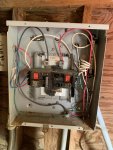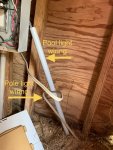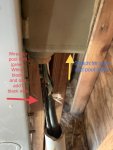In-ground pool light is dead. In fact, never has worked.
Pole light used to work, but hasn’t for years.
Finally got around to having a good look for a transformer yesterday. No plates in the concrete, nearby posts, etc. Is there a chance the pole light (fixture?) could somehow be used as a transformer?
If no, unless it’s incorporated into something within the sub panel, we don’t have such.
So what’s involved in installing a transformer? Does it have to be near the light (cutting through concrete pad) or is there a better option? Maybe installed in our pump house or on the pole light, is there a light we can purchase that houses the transformer in it?
Intend to do whatever work I’m comfortable with (pulling through new wires, attaching light to niche, etc) but have an electrician make the connections and check everything out. Is that a good idea, or no?
Thanks for any info you can offer
Pole light used to work, but hasn’t for years.
Finally got around to having a good look for a transformer yesterday. No plates in the concrete, nearby posts, etc. Is there a chance the pole light (fixture?) could somehow be used as a transformer?
If no, unless it’s incorporated into something within the sub panel, we don’t have such.
So what’s involved in installing a transformer? Does it have to be near the light (cutting through concrete pad) or is there a better option? Maybe installed in our pump house or on the pole light, is there a light we can purchase that houses the transformer in it?
Intend to do whatever work I’m comfortable with (pulling through new wires, attaching light to niche, etc) but have an electrician make the connections and check everything out. Is that a good idea, or no?
Thanks for any info you can offer
Attachments
-
 9690E4DD-F20B-4F93-B791-9332598C1F57.jpeg444.9 KB · Views: 92
9690E4DD-F20B-4F93-B791-9332598C1F57.jpeg444.9 KB · Views: 92 -
 D9E959CC-5F6A-444F-BBC9-0F36A88589F9.jpeg432.3 KB · Views: 89
D9E959CC-5F6A-444F-BBC9-0F36A88589F9.jpeg432.3 KB · Views: 89 -
 B254561E-EB16-43EC-960F-90CA92788B4C.jpeg423 KB · Views: 76
B254561E-EB16-43EC-960F-90CA92788B4C.jpeg423 KB · Views: 76 -
 487A3312-4CB2-421D-9D9C-3DD8285E1DF7.jpeg338.5 KB · Views: 78
487A3312-4CB2-421D-9D9C-3DD8285E1DF7.jpeg338.5 KB · Views: 78 -
 974B0FFB-4A46-4972-A212-4C87F7201881.jpeg289.2 KB · Views: 75
974B0FFB-4A46-4972-A212-4C87F7201881.jpeg289.2 KB · Views: 75


 Nothing like an excuse to go to the hardware store to buy stuff.
Nothing like an excuse to go to the hardware store to buy stuff. 